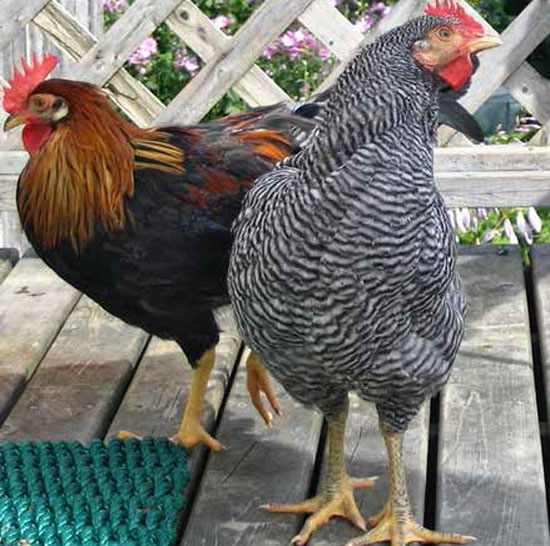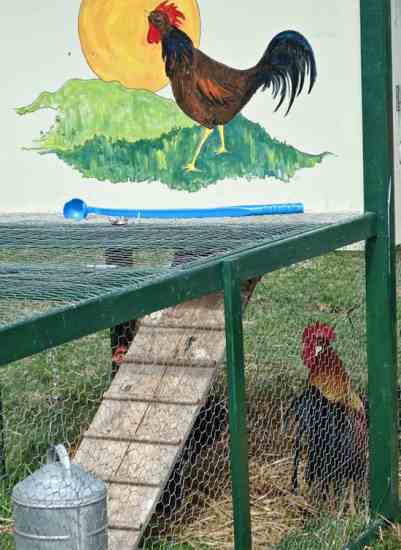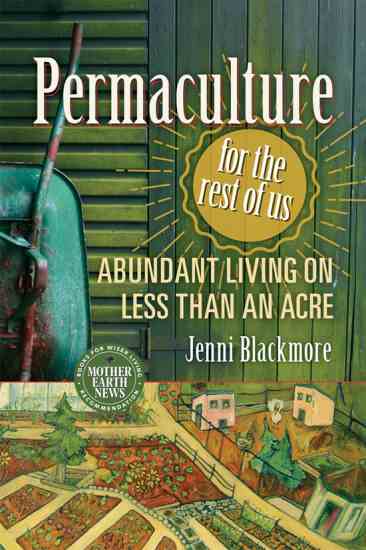In praise of chickens, I will say this: even on a cold, stormy day (and believe me we do have our share of storms here along the coast) after gearing up and fighting a path out to the animal sheds, there is something innately satisfying about chickens, tucked safely in their straw, bumbling a muted “thank you” for the feed and hopefully providing a few eggs. It’s difficult to explain this logically but I believe that by reaching under a chicken for a warm egg we also reach deeper within ourselves, satisfying a primal need to be more intimately connected with our food, honoring its provenance, rather than simply taking it as something sterile, from a cooler, in an over-lit food mart.
This need for closer connection and deeper understanding goes beyond food and in a way represents the heart of permaculture, as the need to integrate with natural systems rather than to remain distanced from them, as modern society would have us do.
Chickens (and this could be extended to poultry in general) are often used as examples of a perfect closed cycle, from a permaculture point of view. They consume kitchen scraps and garden waste and supply eggs and meat. They provide manure which in turn will be used to create more kitchen scraps and garden waste. The eggs they produce feed us but also create more chickens. There is no waste and the process is cyclical and ongoing.

Choosing Chickens For Your Permaculture Garden
It’s probably best to first decide what you want from your chickens. Is it eggs, meat or the best of both? This is an area of compromise as there is no perfect bird. We wanted to raise heritage breeds, preferably endangered breeds that were primarily for egg production. We eventually settled on Barred Plymouth Rocks (a dual purpose breed) and Brown Leghorns. If you’re not planning to hatch and raise purebred chicks you could easily try a broader selection, but if you do want to raise your own chicks, a word of warning: it’s very easy to be tempted to raise several different breeds at once. After all, what’s a couple of extra incubators, right? Keep in mind that each breed needs to be isolated for at least three weeks, with their own specific rooster, before hatchlings can be guaranteed pure-bred. This might explain why some chicken houses have the amoeba-like habit of growing additional cells on all sides. Having witnessed some nightmarish situations like this, I’m inclined to side with the less-is-more principle of permaculture on this particular topic. Also, it’s good to remember that all those cute little chicks rapidly grow into teenaged marauders. I’ve had my own nightmare situations relating to a basement full of feathered young’uns, all with an unnatural propensity to escape their carefully constructed nursery pens. Not good! It really is best to start small and move slowly.
How Chickens Enhance a Permaculture Garden
Two structures that maximize the wonderful ability chickens have to enhance growing conditions are the “henposter” and the chicken tractor. A henposter is simply an area enclosed with a low wall that allows chickens access to all the garden waste and kitchen scraps that are dumped within its perimeter. Our henposter is about four feet square and about eighteen inches high. The chickens think it’s the best fast-food hangout in Cluck-Cluck County and spend many happy hours within its confines pecking and scratching and pooping and in fact producing the best compost imaginable, in a very short time.
The soil in the rest of the chicken compound is also astoundingly fertile. A couple of years ago I dug a drainage ditch and piled the soil off to one side of a garden bed. Later, as I was thinning squash plants, I threw a handful of wannabe seedlings over my shoulder and they happened to land on the pile of soil removed from the chicken coop. Somehow that clump of seedlings managed to root and they became the dominant plants in the squash bed, nicknamed Stealth Squash due to their habit of snagging ankles with the excess vine growth that would creep onto the pathways overnight. I believe it is the constant aeration, due to chickens’ love for scratching the ground, combined with their ongoing manuring, that creates such wonderful fertility.
The chicken tractor also makes good use of chickens. A chicken tractor is a small light weight plough that is pulled by a team of six to eight chickens…. Oooops, sorry! I just couldn’t resist. Seriously, a chicken tractor is simply moveable chicken accommodation, a bit like a gypsy caravan, with its own backyard attached. It has a couple of wheels on one end and handles on the other and no, the chickens don’t pull it from one location to the next, their humans do. Chicken tractors can be just about any size, but are usually about four feet wide and eight to ten feet long. Unless you have a “real” tractor or a lot of very strong friends, they mustn’t be too heavy. The trick is to build them big enough to house several chickens comfortably, and strong enough to keep predators out, but light enough to move without too much effort. They are excellent parked in a proposed new garden site or over a difficult weed patch that needs to be tamed. In this way the chickens help conserve energy, in this case mine, by doing the work for me.

Our chicken tractor is designed so that it can be placed over dormant and pre-dormant garden beds. It is also the summer home for our leghorn flock, conveniently keeping the two breeds separated during breeding season. This speaks in a small way to another permaculture principle. Elements can and should be designed to be multi-functional within any system. Sometimes this can require something as simple as thoughtful placement.
Well considered placement leads to yet another of the essential elements of permaculture: the sector map. Assuming that a fairly accurate map of the property has already been drawn, the sector map ensures that any new elements being introduced will be installed in the optimum location, where they might in fact serve more than their one intended purpose. For instance, strategic positioning of a shed or clump of bushes can create a useful microclimate. The south wall of the shed can also form the support for espaliered fruit trees or grape vines and further, if the shed is painted white it will help to reflect heat and light back onto the plants close by.
Vines planted on the north side of a shed in a windy location will probably not produce any fruit, whereas in the microclimate described above those same vines can be expected to produce a good harvest. This is why it’s so important to drawn up a zone and sector map before any serious changes are made. It’s mostly just common sense and certainly not that complicated, and yet this is one of the cardinal rules of permaculture design that I instinctively wanted to avoid. Why? I don’t know. It’s really not that difficult to determine compass points, prevailing wind and water flow, and sun angles for both summer and winter. This invaluable information can be drawn on an overlay placed on top of a property map showing elements already present on the land, such as dwellings, outbuildings, pathways, etc.
And how did we get from chickens to zones and sector maps? Easy. Just a hop and a skip! These maps will indicate where best to locate, among other things, the chicken run. Close enough to facilitate twice daily visits (zone two or three) but not close enough to draw vermin to the heart/house (zone one); preferably not upwind but within crowing distance, because surely the call of a rooster welcoming the dawn sounds sweeter than the harsh electronic beep of a preset alarm? This just goes to show how tightly integrated and non-linear things are in Permieville, because of course we can just as easily circle back and let the ladies of the Cluck-Cluck County laying-circle have the final words of praise for their prodigious output.
And what does one do with all the eggs? In the spring and early summer, with the ducks and the turkeys as well as the chickens all laying to capacity, the surplus can be overwhelming. We sell at the local market, and we pickle them and curry them and make amazing spinach salads, and potato salads and quiches and frittatas and soufflés and custards and sauces and biscotti and the list goes on…
There’s something very beautiful about a fresh laid egg, still warm from the nest box. It stirs my soul to simply hold one in my hand and after several years of tending hens I still find myself thinking “This is amazing. What a gift!” Living in tune with nature, as permaculture has us do, really does help to put the true magnificence of this world into clearer focus.
Reprinted with permission from Permaculture for the Rest of Us by Jenni Blackmore and published by New Society Publishers, 2015. Buy this book from our store: Permaculture for the Rest of Us.

https://www.communitychickens.com/chickens-permaculture-garden-design/
On – 25 Oct, 2017 By Community Chickens



